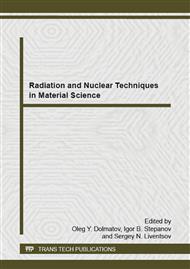[1]
A. Capucci, D. Ashieri, G. Villani, Epidemiologia e trattamento della fibrillazione atriale, Ann. Ital. Med. Int. 4 (1996) 413-421.
Google Scholar
[2]
H. Lin, P. Wolf, M. Kelly-Hayes, A.S. Beiser, C.S. Kase, E.J. Benjamin, R.B. D'Agostino, Stroke severity in atrial fibrillation. The Framingham Study, J. Stroke. 27 (1996) 1760-1764.
DOI: 10.1161/01.str.27.10.1760
Google Scholar
[3]
E. O'Connel, C. Gray, J. French, I. Robertson, Atrial fibrillation and cognitive function: case-control study, J. Neurol. Neurosurg. Psych. 65 (1998) 386–389.
Google Scholar
[4]
A. Hagendorff , C. Dettmers , W. Jung, M. Hümmelgen, C. Kölsch, A. Hartmann, B. Lüderitz, D. Pfeiffer, Cardiac pacemaker therapy for optimizing brain circulation. A possible prevention for cerebrovascular diseases, Deutsch. Med. Wochenschr. 10 (2000).
DOI: 10.1055/s-2007-1024118
Google Scholar
[5]
Y. Yonekura, S. Nishizawa, T. Mukai, SPECT with 99m-Tc- d, l –hexamethyl propylene amine oxime (HM-PAO) compared with regional cerebral blood flow measured by PET. Effects of linearization, J. Cerebral Blood Flow & Metab. 8 (1988) 82-89.
DOI: 10.1038/jcbfm.1988.36
Google Scholar
[6]
N.A. Lassen, A.R. Andersen, L. Fribrg, O.B. Paulson, The Retention of [99m-Tc]-d, l, -HMPAO in the Human Brain after Intracarotid Bolus injection: A Kinetic Analysis, J. Cerebral Blood Flow & Metab. 8 (1988) 13-22.
DOI: 10.1038/jcbfm.1988.28
Google Scholar
[7]
A.R. Luriya, The higher cortical functions of a human being and their disorders in local brain injuries, Moscow State University Publ., Moscow, 1969 (in Russian).
Google Scholar
[8]
D . Wechsler, Wechsler Memory Scale-Revised. Manual. Psychological Corporation, New York (1987).
Google Scholar
[9]
M. Grimm, D. Zimpfer, M. Czerny, J. Kilo, M.T. Kasimir, L. Kramer, A. Krokovay, E. Wolner, Neurocognitive deficit following mitral valve surgery, Eur. J. Cardiothorac. Surg. 23 (2003) 265-271.
DOI: 10.1016/s1010-7940(02)00843-6
Google Scholar
[10]
J. O'Brien, T. Erkinjutti, B. Reisberg, G. Roman, T. Sawada, L. Pantoni, J.V. Bowler, C. Ballard, C. DeCarli, P.B. Gorelick, K. Rockwood, A. Burns, S. Gauthier, S.T. DeKosky, Vascular cognitive impairment, Lancet. 2 (2003) 89-98.
DOI: 10.1016/s1474-4422(03)00305-3
Google Scholar
[11]
M. Elias, L. Sullivan, R. D'Agostino, Framingham stroke risk profile and lowered cognitive performance, J. Stroke. 35 (2004) 404-409.
DOI: 10.1161/01.str.0000103141.82869.77
Google Scholar
[12]
M. Weigl, A. Moritz, B. Steinlechner, I. Schmatzer, B. Mora, R. Fakin, D. Zimpfer, H.J. Ankersmit, C. Khazen, M. Dworschak, Neuronal injury after repeated brief cardiac arrests during internal cardioverter defibrillator implantation is associated with deterioration of cognitive function non-valvular atrial fibrillation and cognitive decline: a longitudinal cohort study, J. Anesth. Analg. 103 (2006).
DOI: 10.1213/01.ane.0000226088.59744.3e
Google Scholar
[13]
M. Stoddard, P. Dawkins, C. Prince, N. Ammash, Left atrial appendage thrombus is not uncommon in patients with acute atrial fibrillation and a recent embolic event: a transesophageal echocardiographic study, J. Am. Coll. Cardiol. 2 (1995).
DOI: 10.1016/0735-1097(94)00396-8
Google Scholar
[14]
M. Ezekowitz, K. James, S.M. Nazarian, J. Davenport, J.P. Broderick, S.R. Gupta, V. Thadani, M.L. Meyer, S.L. Bridgers, Silent cerebral infarction in patients with nonrheumatic atrial fibrillation, J. Circulation 92 (1995) 2178-2182.
DOI: 10.1161/01.cir.92.8.2178
Google Scholar
[15]
W. Feinberg, J. Seeger, R. Carmody, D.C. Anderson, R.G. Hart, L.A. Pearce, Epidemiologic features of asymptomatic cerebral infarction in patients with nonvalvular atrial fibrillation, Arch. Intern. Med. 150 (1990) 2340-2344.
DOI: 10.1001/archinte.1990.00390220082016
Google Scholar
[16]
G. Lip, D. Beevers, S. Singh, R. Watson, ABC of atrial fibrillation: Aetiology, pathophysiology, and clinical features, Br. Med. J. 311 (1995) 1425-1428.
DOI: 10.1136/bmj.311.7017.1425
Google Scholar


